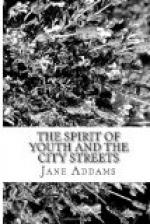A factory boy who had been brought into the Juvenile Court many times because of his persistent habit of borrowing the vehicles of physicians as they stood in front of houses of patients, always meaning to “get back before the doctor came out,” led a contented and orderly life after a place had been found for him as a stable boy in a large livery establishment where his love for horses could be legitimately gratified.
Still another boy made the readjustment for himself in spite of the great physical suffering involved. He had lost both legs at the age of seven, “flipping cars.” When he went to work at fourteen with two good cork legs, which he vainly imagined disguised his disability, his employer kindly placed him where he might sit throughout the entire day, and his task was to keep tally on the boxes constantly hoisted from the warehouse into cars. The boy found this work so dull that he insisted upon working in the yards, where the cars were being loaded and switched. He would come home at night utterly exhausted, more from the extreme nervous tension involved in avoiding accidents than from the tremendous exertion, and although he would weep bitterly from sheer fatigue, nothing could induce him to go back to the duller and safer job. Fortunately he belonged to a less passionate race than the poor little Italian girl in the Hull-House neighborhood who recently battered her head against the wall so long and so vigorously that she had to be taken to a hospital because of her serious injuries. So nearly as dull “grown-ups” could understand, it had been an hysterical revolt against factory work by day and “no fun in the evening.”
America perhaps more than any other country in the world can demonstrate what applied science has accomplished for industry; it has not only made possible the utilization of all sorts of unpromising raw material, but it has tremendously increased the invention and elaboration of machinery. The time must come, however, if indeed the moment has not already arrived, when applied science will have done all that it can do for the development of machinery. It may be that machines cannot be speeded up any further without putting unwarranted strain upon the nervous system of the worker; it may be that further elaboration will so sacrifice the workman who feeds the machine that industrial advance will lie not in the direction of improvement in machinery, but in the recovery and education of the workman. This refusal to apply “the art of life” to industry continually drives out of it many promising young people. Some of them, impelled by a creative impulse which will not be denied, avoid industry altogether and demand that their ambitious parents give them lessons in “china painting” and “art work,” which clutters the overcrowded parlor of the more prosperous workingman’s home with useless decorated plates, and handpainted “drapes,” whereas the plates upon the table and the rugs upon the floor used daily by thousands of weary housewives are totally untouched by the beauty and variety which this ill-directed art instinct might have given them had it been incorporated into industry.




